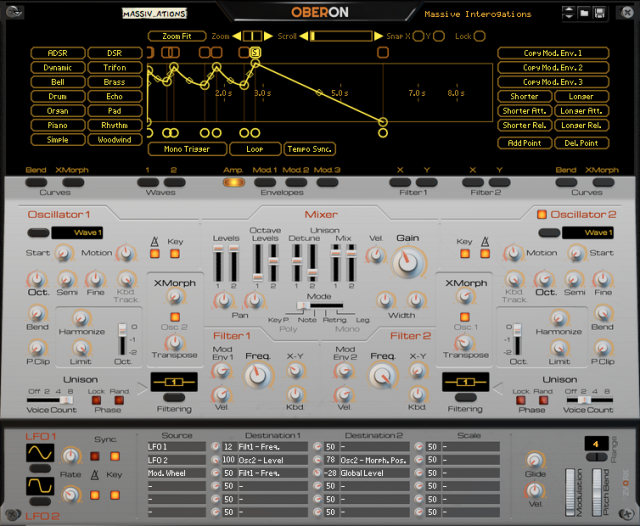
Zvork Audio has released Oberon – a new software synthesizer Rack Extension for Propellerhead Reason.
The Oberon synthesizer has two oscillator sections and two filters. Each oscillator can be fed to one of the two filters or to both, in serial or parallel mode. These filters enable you to alter the timbre of your sound but are not the only mean to do so. Each oscillator can generate a number of different waves, from simple sawtooth and square to more complex metallic or robotic sounds. Each of these waves is in reality a wave sequence that can be played at different speeds.
Here’s a video patch demo:
Features:
- Multi-point loop-able envelopes – Each of Oberon’s four envelopes are defined by a user editable curve, with up to 16 points. These envelopes are loop-able, between the start and sustain point, with a tempo synchronization option.
- Editable waves – There are two editable waves, or wave sequences, that the user can customize. For each of these wave sequences, two editable curves let you draw the shape of the start and end waveforms of the sequence.
- Editable Filter response curves – In Oberon, the filters don’t have predefined modes such as low pass, high pass or comb. Instead you define the filter response yourself, again with an editable curve. Each filter response can morph between two curves for even more dramatic and changing effects.
- X-Morph between oscillators – This feature lets you smoothly morph between two sound sources, potentially of different pitches and timbre. Morph between a pitch downed version of the same oscillator or between oscillator 1 and oscillator 2 for original transitions. The morphing effect can also be masked for certain portions of the spectrum if, for instance, you want to apply the character of one sound source solely to the high frequencies.
- Unison and Octave virtual voices – To fatten your sounds, each oscillator can be virtually duplicated up to 8 times with a pitch detune. After that, if this isn’t enough, another virtual copy of the resulting sound can be added to your final sound mix at an octave higher.
- Timbre bend – If you are in need of metallic inharmonic sounds, this is the functionality you need. With it you can quickly bend your sound to mimic highly rigid strings, bells or quirky buzzes, in a predictable way.
- Separate voice audio and gate outputs – On the back panel you will find 8 separate outputs for both stereo audio and CV gate. Individual voices can be distributed among these outputs.
- Patches – Oberon comes with over 300 patches in all categories.
Oberon is available now from the Propellerhead site for US $99.

and the reason is???
yeah i know its bad
Fancy GUI, but any of these sounds are possible with Thor.
I find Thor’s GUI to be too cluttered for my tastes. This one is cleaner, but ups the game with Bezier curve tools. If you really want to personalize your sounds to a higher degree, those allow you to sculpt in detail and its a lot less maddening than pure additive. I see them in Serum as well. Any synth that provides those is serious on a higher level than a ROMpler. Its a major plus if you have an itch to program.
Holy dog shit that’s an ugly GUI. Looks almost unusable. Seriously.
It would be fine if it had “Futurama” characters as the main panel’s skin.
NI Razor like interface, I-pad sound from the demo anyway, on flip side, Thor is definitely one of my best instruments on the I-Pad or Computer dated as it may be, when it’s right. it’s right, like my Moog.